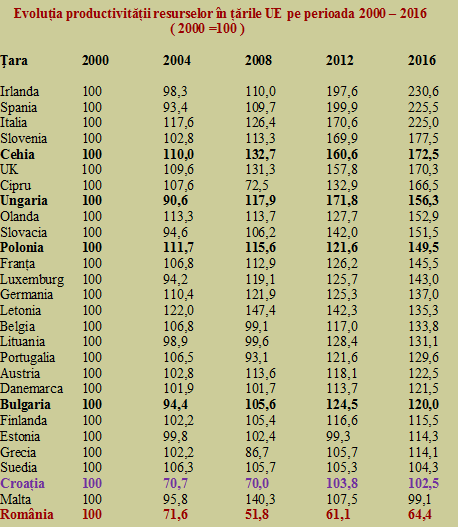 Romania ranks second to last among the EU member states in terms of resource productivity in the economy, with only EUR 0.70 per kilogram of raw material used in 2016, according to the data communicated by Eurostat.
Romania ranks second to last among the EU member states in terms of resource productivity in the economy, with only EUR 0.70 per kilogram of raw material used in 2016, according to the data communicated by Eurostat.
Surprisingly, we register less than two-thirds of the index recorded in 2000 and still stagnate since 2001 onwards.
At the same time, for the reference, we should mention that we slightly surpass Bulgaria (0.68 euro/kg), we equal only one third of the EU27 average (2.07 euro/kg) and remain at a substantial distance from countries such as Italy (EUR 3.69/kg), the United Kingdom (EUR 3.59/kg) or Spain (EUR 3.17/kg).
 The only country that registered a decrease between 2000 and 2016 in resource productivity
The only country that registered a decrease between 2000 and 2016 in resource productivity
The Eurostat analysis shows that between 2000 and 2016, when resource productivity increased overall in the EU member states from 1.47 euro/kg to 2.07 euro/kg (by 41% in real terms), Romania registered a decrease at this key indicator for the quality of the economy growth, from 1.09 euro/kg to 0.70 euro/kg.
Consequently, the ratio between us and the European average has deteriorated from 74% to 34%.
BOX
The productivity of a country’s resources is measured by dividing its GDP by its consumption of materials (from domestic production plus the balance between imported and exported raw materials). To ensure the comparability between different countries, GDP per capita is calculated at the parity of standard purchasing power, and to track the evolution over time, GDP per capita is used in real terms, adjusted by the volume to the prices in a reference year.
The champion of improving the resource efficiency since 2000 is Ireland, which has achieved a very strong improvement in this economic indicator over the last 12 years. The country is followed closely by Spain and Italy. The next group, at a greater distance and with the UK standing out, is led by two colleagues from the former socialist bloc, Slovenia and the Czech Republic.
Hungary and Poland also successfully registered very good results during this century, countries which, having the advantage of a start from a lower base of performance in the field, have surpassed (as we should have done) the two European reference economies, France and Germany.
It is noteworthy that even our Bulgarian neighbours have improved their result by 20%, and especially the new EU member Croatia, which went through a period of strong recoil similar to ours in 2004, returned to higher levels than the values from the starting point.
*
- Evolution of resource productivity in the EU countries between 2006-2016 (2000=100)
- Country
*
Resource productivity in Romania has sharply declined until 2008, that is, precisely in the period of economic growth. The shift from the „tailor of Europe” position to the „smith of Europe” position was accompanied by an inherent deterioration in the ratio between the amount obtained and the quantity of resources consumed. That could not be offset by the added-value growth, despite a clear shift towards the medium-level technology products.
The recovery from the past eight years analysed has somehow improved the disastrous situation of the indicator, but puts us still on the last place in the European Union as a trend and has barely saved us from getting the red flashlight in absolute value.
Starting from the damage level of 2008, the growth rate was slightly better than the European average (34% increase in resource productivity in 2016 compared to 31% the EU average over the same period) but totally insufficient for reducing the gap with the other countries.
So, beyond the quantitative economic results that look good at first sight, we should be more careful about the quality of growth, because this is the weakest segment for us from the perspective of the real convergence with the EU economies. In short, without neglecting the quantitative expansion, we urgently need a much clearer intensive growth.
Of course, the situation can only be improved in the long run. To do that, we should smartly target strategic areas for improving the resource productivity and not take chaotic measures for the whole economy. In addition, we should not forget about education, because it is hard to believe that we will be able to sell more efficiently processed material resources without having educated human resources.
Only this way we shall be able to preserve and enhance our competitiveness (which is increasingly difficult in an enlarged single market). The competitiveness that will materialize in the gradual and partial substitution of the material consumption with wage increases. Obtained not by some administrative measures of arbitrary nominal wage increases, but by the demand and supply, in a labour market sustained by a strong national currency.










